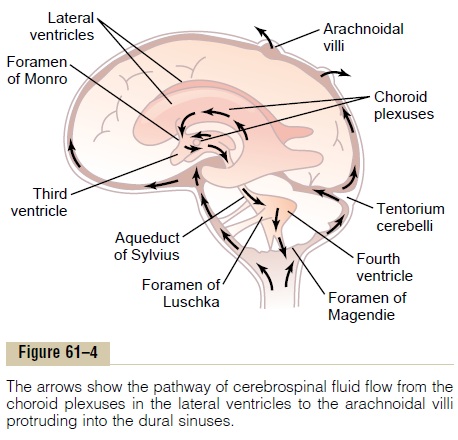Chapter: Medical Physiology: Cerebral Blood Flow, Cerebrospinal Fluid, and Brain Metabolism
Blood-Cerebrospinal Fluid and Blood-Brain Barriers
Blood-Cerebrospinal Fluid and Blood-Brain Barriers
It has already been pointed out that the concentrations of several important constituents of cerebrospinal fluid are not the same as in extracellular fluid elsewhere in the body. Furthermore, many large molecular sub-stances hardly pass at all from the blood into the cere-brospinal fluid or into the interstitial fluids of the brain, even though these same substances pass readily into the usual interstitial fluids of the body. Therefore, it is said that barriers, called the blood–cerebrospinal fluidbarrier and the blood-brain barrier, exist between theblood and the cerebrospinal fluid and brain fluid, respectively.
Barriers exist both at the choroid plexus and at the tissue capillary membranes in essentially all areas of the brain parenchyma except in some areas of the hypothal-amus, pineal gland, and area postrema, where substancesdiffuse with greater ease into the tissue spaces. The ease of diffusion in these areas is important because they have sensory receptors that respond to specific changes in the body fluids, such as changes in osmolality and in glucose concentration, as well as receptors for peptide hormones that regulate thirst, such as angiotensin II. The blood-brain barrier also has specific carrier mole-cules that facilitate transport of hormones, such as leptin, from the blood into the hypothalamus where they bind to specific receptors that control other func-tions such as appetite and sympathetic nervous system activity.
In general, the blood–cerebrospinal fluid and blood-brain barriers are highly permeable to water, carbon dioxide, oxygen, and most lipid-soluble substances such as alcohol and anesthetics; slightly permeable to electrolytes such as sodium, chloride, and potassium; and almost totally impermeable to plasma proteins and most non–lipid-soluble large organic molecules. There-fore, the blood–cerebrospinal fluid and blood-brain bar-riers often make it impossible to achieve effective concentrations of therapeutic drugs, such as protein antibodies and non–lipid-soluble drugs, in the cere-brospinal fluid or parenchyma of the brain.
The cause of the low permeability of the blood– cerebrospinal fluid and blood-brain barriers is the manner in which the endothelial cells of the brain tissue capillaries are joined to one another. They are joined by so-called tight junctions. That is, the membranes of the adjacent endothelial cells are tightly fused rather than having large slit-pores between them, as is the case for most other capillaries of the body.

Related Topics